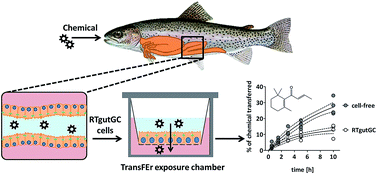当前位置:
X-MOL 学术
›
Anal. Methods
›
论文详情
Our official English website, www.x-mol.net, welcomes your
feedback! (Note: you will need to create a separate account there.)
TransFEr: a new device to measure the transfer of volatile and hydrophobic organic chemicals across an in vitro intestinal fish cell barrier†
Analytical Methods ( IF 2.7 ) Pub Date : 2018-07-17 00:00:00 , DOI: 10.1039/c8ay01253a Hannah Schug 1, 2, 3, 4, 5 , Frédéric Begnaud 4, 6, 7, 8 , Christian Debonneville 4, 6, 7, 8 , Fabienne Berthaud 4, 6, 7, 8 , Sylvia Gimeno 9, 10, 11 , Kristin Schirmer 1, 2, 3, 4, 5
Analytical Methods ( IF 2.7 ) Pub Date : 2018-07-17 00:00:00 , DOI: 10.1039/c8ay01253a Hannah Schug 1, 2, 3, 4, 5 , Frédéric Begnaud 4, 6, 7, 8 , Christian Debonneville 4, 6, 7, 8 , Fabienne Berthaud 4, 6, 7, 8 , Sylvia Gimeno 9, 10, 11 , Kristin Schirmer 1, 2, 3, 4, 5
Affiliation

|
Transfer of compounds across cellular barriers is a critical step of compound uptake into organisms. Using in vitro barrier systems to evaluate such transfer is attractive because of the higher throughput and reduced resource needs compared to animal studies. Thus far, however, studying the transfer of hydrophobic and volatile compounds was hampered by the unavailability of in vitro exposure systems that allow for stable and predictable chemical exposure concentrations. To overcome this limitation, we constructed a novel exposure chamber, TransFEr, and tested it with an in vitro epithelial barrier model using the rainbow trout (Oncorhynchus mykiss) intestinal cell line, RTgutGC. Key features of the chamber are its closed design and rotatable silicon segments, which can serve for chemical dosing and sampling. Using the fragrance damascone beta (log KOW: 3.7, log HLC: −3.9) as a pilot chemical, we were able to demonstrate that our exposure chamber provides for stable chemical exposure concentrations and full mass balance. The RTgutGC epithelium served as barrier for damascone beta transfer, which we attribute to chemical retention and biotransformation in the intestinal cells. Nevertheless, substantial transfer of the chemical across the epithelium occurred. When a chemical sink, i.e. a silicon segment, was included in the basolateral chamber to mimic blood constituents binding in vivo, transfer was about three-fold enhanced. We suggest that the presented methodology can help to obtain insights into chemical uptake mechanisms via the intestinal or other epithelia of fish and other animals for hydrophobic and volatile chemicals.
中文翻译:

TransFEr:一种用于测量挥发性和疏水性有机化学物质在体外肠道鱼细胞屏障中转移的新设备†
化合物跨细胞屏障的转移是化合物吸收进入生物体的关键步骤。与动物研究相比,由于更高的通量和减少的资源需求,使用体外屏障系统评估这种转移是有吸引力的。然而,到目前为止,由于无法获得允许稳定且可预测的化学暴露浓度的体外暴露系统,阻碍了对疏水性和挥发性化合物转移的研究。为了克服这一限制,我们构建了一个新颖的暴露室TransFEr,并使用虹鳟鱼(Oncorhynchus mykiss)在体外上皮屏障模型中对其进行了测试。)肠细胞系RTgutGC。腔室的主要特点是其封闭式设计和可旋转的硅片,可用于化学计量和采样。使用香料damascone beta(log K OW:3.7,log HLC:-3.9)作为试验化学品,我们能够证明我们的暴露室可提供稳定的化学品暴露浓度和完整的质量平衡。RTgutGC上皮充当了damasconeβ转移的屏障,我们将其归因于肠道细胞中的化学保留和生物转化。然而,发生了化学物质跨上皮的大量转移。当在基底外侧腔中包含化学沉池(即硅段)以模拟体内结合的血液成分时,传输能力提高了约三倍。我们建议,提出的方法可以帮助通过鱼类和其他动物的肠道或其他上皮细胞获取疏水性和挥发性化学物质对化学物质吸收机制的见解。
更新日期:2018-07-17
中文翻译:

TransFEr:一种用于测量挥发性和疏水性有机化学物质在体外肠道鱼细胞屏障中转移的新设备†
化合物跨细胞屏障的转移是化合物吸收进入生物体的关键步骤。与动物研究相比,由于更高的通量和减少的资源需求,使用体外屏障系统评估这种转移是有吸引力的。然而,到目前为止,由于无法获得允许稳定且可预测的化学暴露浓度的体外暴露系统,阻碍了对疏水性和挥发性化合物转移的研究。为了克服这一限制,我们构建了一个新颖的暴露室TransFEr,并使用虹鳟鱼(Oncorhynchus mykiss)在体外上皮屏障模型中对其进行了测试。)肠细胞系RTgutGC。腔室的主要特点是其封闭式设计和可旋转的硅片,可用于化学计量和采样。使用香料damascone beta(log K OW:3.7,log HLC:-3.9)作为试验化学品,我们能够证明我们的暴露室可提供稳定的化学品暴露浓度和完整的质量平衡。RTgutGC上皮充当了damasconeβ转移的屏障,我们将其归因于肠道细胞中的化学保留和生物转化。然而,发生了化学物质跨上皮的大量转移。当在基底外侧腔中包含化学沉池(即硅段)以模拟体内结合的血液成分时,传输能力提高了约三倍。我们建议,提出的方法可以帮助通过鱼类和其他动物的肠道或其他上皮细胞获取疏水性和挥发性化学物质对化学物质吸收机制的见解。











































 京公网安备 11010802027423号
京公网安备 11010802027423号